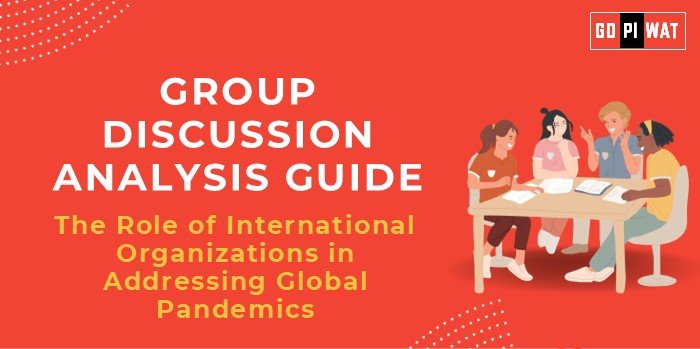📋 Group Discussion (GD) Analysis Guide
🌐 The Role of International Organizations in Addressing Global Pandemics
📖 Introduction to the Topic
Opening Context: The COVID-19 pandemic highlighted the indispensable role of international organizations in managing global health crises. Their coordination efforts ensure equitable vaccine distribution, resource mobilization, and standardized health responses worldwide.
Topic Background: From the World Health Organization’s (WHO) global alert system to the World Bank’s pandemic response funds, international organizations have been at the forefront of combating pandemics. Their strategies, however, often face scrutiny regarding efficiency, equity, and global collaboration.
📊 Quick Facts and Key Statistics
- 🌍 WHO’s Budget: $7.96 billion (2023-24) – Essential for coordinating pandemic responses globally.
- 💉 COVID-19 Vaccine Distribution: 2 billion doses delivered by COVAX by 2022 – Ensures access to low-income countries.
- ⚰️ Global Pandemic Death Toll (2020-2023): Over 6.8 million deaths – Reflects the urgency of international preparedness.
- 💸 Health Spending Gap: $370 billion annually in developing nations – Impedes pandemic mitigation.
🌟 Stakeholders and Their Roles
- 🏛️ International Organizations (WHO, UN, World Bank): Strategy coordination, funding, and technical guidance.
- 🌐 National Governments: Implementing policies and maintaining health infrastructure.
- 🏢 Pharmaceutical Companies: Vaccine and therapeutic innovations.
- 🤝 Civil Society Organizations (e.g., Red Cross): Grassroots health service delivery.
🏆 Achievements and Challenges
✨ Achievements
- ✅ COVAX Initiative: Vaccinated over 30% of populations in 92 low-income countries.
- 🌍 Global Health Regulations: Coordinated travel advisories and public health protocols during COVID-19.
- 💊 Global Fund Efforts: Addressed HIV, TB, and malaria while integrating pandemic responses.
⚠️ Challenges
- ⚖️ Vaccine Inequality: Africa received only 3% of vaccines in early 2021.
- ⏳ Coordination Failures: Delayed response during early COVID-19 phases exposed inefficiencies.
- 💵 Funding Gaps: Reliance on voluntary donations limits capacity for sustained efforts.
📘 Global Comparisons:
– Success: South Korea’s use of WHO guidelines for mass testing in 2020.
– Failures: Lack of unified response in Europe during the H1N1 outbreak.
💬 Structured Arguments for Discussion
- ✅ Supporting Stance: “International organizations have been instrumental in saving millions of lives through vaccine distribution and emergency response.”
- ❌ Opposing Stance: “Bureaucratic delays and unequal vaccine allocation undermine the efficiency of international organizations.”
- ⚖️ Balanced Perspective: “While essential, international organizations must address funding gaps and structural inefficiencies to enhance pandemic response.”
💡 Effective Discussion Approaches
- 🌏 Opening Approaches:
- Use a statistical fact: “COVAX delivered 2 billion vaccines but failed to meet its equity targets.”
- Present a case study: “South Korea effectively managed testing using WHO guidelines.”
- 🤔 Counter-Argument Handling:
- Acknowledge inefficiencies but emphasize improvements: “Despite delays, the WHO has implemented reforms like ACT Accelerator.”
🔍 Strategic Analysis of Strengths and Weaknesses
- 💪 Strengths: Global reach and standardized protocols; strong network of member states.
- ⚖️ Weaknesses: Dependency on voluntary funding; limited enforcement power.
- 📈 Opportunities: Strengthen public-private partnerships; invest in AI-based early detection systems.
- ⚠️ Threats: Political interference; rising vaccine nationalism.
🎓 Connecting with B-School Applications
- 🌍 Real-World Applications: Health economics in policy-making projects; operations research in supply chain management for vaccines.
- 💬 Sample Interview Questions:
- “How can public-private partnerships improve global pandemic responses?”
- “Evaluate the WHO’s performance during the COVID-19 pandemic.”
- 💡 Insights for Students:
- Pandemic response showcases leadership and supply chain efficiency lessons.
- Understand the role of international organizations in global health governance.


